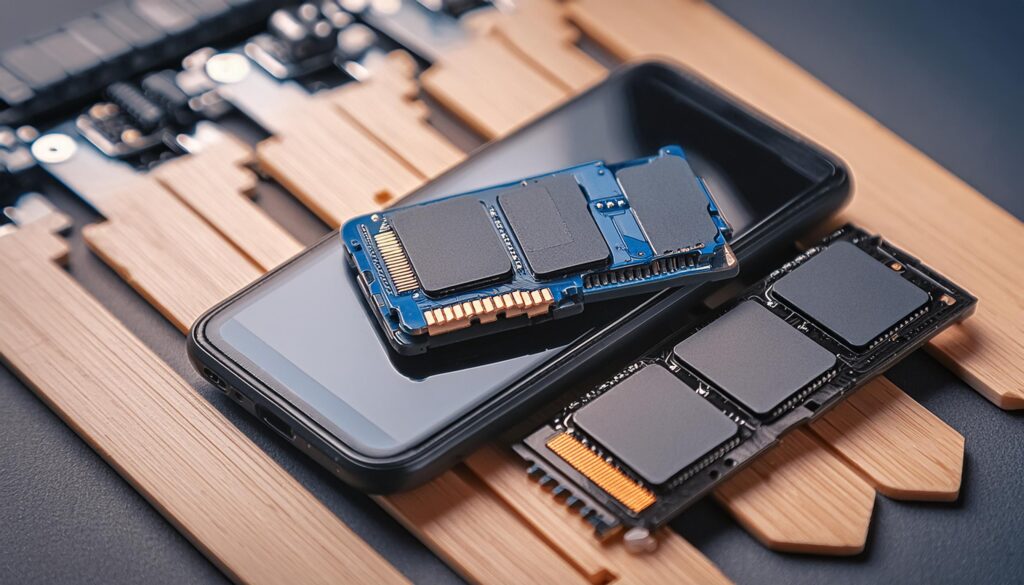
When it comes to choosing a smartphone, one critical aspect that often influences purchasing decisions is the internal memory. Internal memory, sometimes referred to as dynamic memory, plays a vital role in determining the performance and storage capacity of your device. Here’s an in-depth look at what internal memory entails, its types, and why it matters for your smartphone experience.
What is Internal Memory?
Internal memory in smartphones refers to the built-in storage that houses the operating system, pre-installed applications, and user data such as photos, videos, and apps. This storage is not just a static repository; it dynamically interacts with the phone’s processor to manage and execute various tasks efficiently.
Types of Internal Memory
eMMC (embedded MultiMediaCard)
eMMC is a common type of internal memory found in budget and mid-range smartphones. It integrates flash memory with a flash memory controller, offering a balance between performance and cost. Key characteristics include:
- Speed: Adequate for everyday tasks such as browsing, streaming, and social media.
- Cost-Effectiveness: More affordable, making it suitable for lower-cost devices.
- Performance: Slower compared to UFS, especially noticeable during intensive tasks like gaming or high-resolution video editing.
UFS (Universal Flash Storage)
UFS is a more advanced type of internal memory that provides significantly faster read and write speeds compared to eMMC. It’s commonly used in mid-range to high-end smartphones. Key benefits include:
- High Speed: Faster data transfer rates, leading to quicker app launches and smoother multitasking.
- Efficiency: Better performance in handling large files and complex applications.
- Enhanced User Experience: Improves overall responsiveness and efficiency, making it ideal for power users and gamers.
Importance of Internal Memory
Performance
The type and size of internal memory directly impact your smartphone’s performance. Larger internal memory allows for more apps and files to be stored without slowing down the device. Faster memory types like UFS ensure that tasks are executed swiftly, enhancing the user experience.
Multitasking
Smartphones with more internal memory can handle multiple applications running simultaneously without lag. This is crucial for users who rely on their phones for productivity, gaming, or media consumption.
Storage Capacity
Internal memory determines how much data your phone can hold. Higher internal storage capacities (e.g., 64GB, 128GB, 256GB, or more) are essential for users who take a lot of photos, download numerous apps, and store large media files.
Longevity
Phones with larger and faster internal memory tend to remain usable for longer periods as they can handle updates and new applications more effectively. This ensures that your device doesn’t become obsolete quickly, offering better value for money.
Managing Internal Memory
Storage Optimization
Many smartphones come with built-in tools to help manage internal memory. These tools can assist in clearing cache, removing unused apps, and managing large files to free up space and maintain performance.
Cloud Storage
Leveraging cloud storage services can help offload data from your phone’s internal memory, ensuring you have ample space for essential apps and files. This is particularly useful for media-heavy users who need to store photos, videos, and music.
External Storage Options
While internal memory is critical, some smartphones offer expandable storage options via microSD cards. This can be a convenient way to increase storage capacity, although it may not match the speed and efficiency of internal UFS storage.
Conclusion
Internal memory is a crucial component that significantly influences a smartphone’s performance, storage capabilities, and overall user experience. Understanding the differences between eMMC and UFS, along with the importance of storage capacity and speed, can help you make an informed decision when selecting your next smartphone. By considering your usage needs and preferences, you can choose a device that offers the right balance of performance and storage, ensuring it meets your demands both now and in the future.